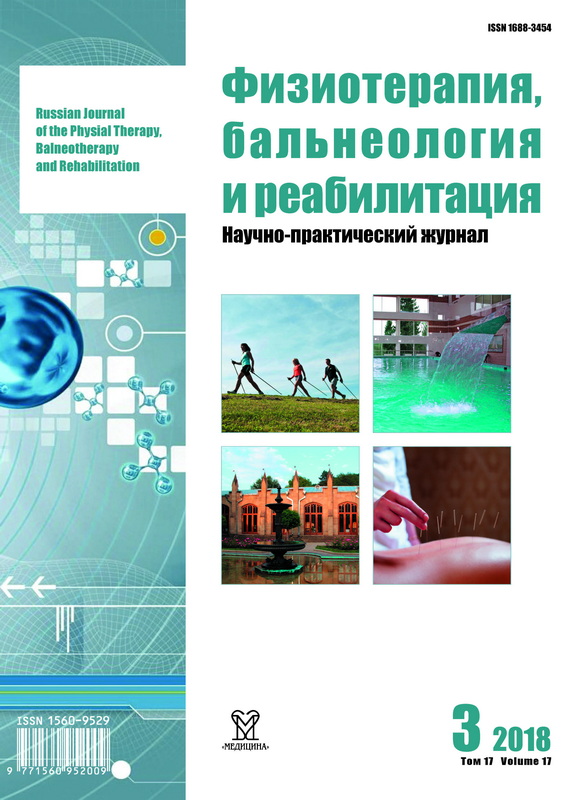Effect of noninvasive neuromodulation in the menopusal period in women
- Authors: Voropaev A.A.1, Gaidarova A.K.1, Kotenko N.V.1, Rachin A.P.1, Badalov N.G.1
-
Affiliations:
- National Medical Research Center for Rehabilitation and Balneology
- Issue: Vol 17, No 3 (2018)
- Pages: 157-161
- Section: Original studies
- Published: 15.09.2020
- URL: https://rjpbr.com/1681-3456/article/view/43616
- DOI: https://doi.org/10.18821/1681-3456-2018-17-3-157-161
- ID: 43616
Cite item
Full Text
Abstract
In women with extragenital pathology in the menopausal period, the use of noninvasive neuromodulation for the treatment of psychovegetative disorders has been proposed. The method allows to reduce the severity of menopausal and psychosomatic (depression, anxiety) disorders and the level of their mutual influence.
About the authors
Aleksey Alekseevich Voropaev
National Medical Research Center for Rehabilitation and Balneology
Author for correspondence.
Email: woropaew@ya.ru
MD, PhD, senior researcher, National Medical Research Center for Rehabilitation and Balneology
Russian Federation, MoscowA. Kh. Gaidarova
National Medical Research Center for Rehabilitation and Balneology
Email: woropaew@ya.ru
Russian Federation, Moscow
N. V. Kotenko
National Medical Research Center for Rehabilitation and Balneology
Email: woropaew@ya.ru
Russian Federation, Moscow
A. P. Rachin
National Medical Research Center for Rehabilitation and Balneology
Email: woropaew@ya.ru
Russian Federation, Moscow
N. G. Badalov
National Medical Research Center for Rehabilitation and Balneology
Email: woropaew@ya.ru
Russian Federation, Moscow
References
- Balan V.E. Urogenital disorders in menopause (clinic, diagnosis, replacement therapy: dis doct. med. sci. Moscow, 1998. 253 p. (In Russ.)
- Voropaev A.A., Gerasimenko M.Yu., Rachin A.P. Application of transcranial electrostimulation in patients with depressive anxiety disorders. Fizioterapiya, Bal’neologiya i Reabilitatsiya (Russian Journal of the Physical Therapy, Balneotherapy and Rehabilitation). 2016; 1(5): 244. (In Russ.)
- Zaidiyev Ya.Z. Hormone prevention and correction of systemic disorders in women in perimenopause: dis. Dr. med. sci. Moscow, 1997. 279 p. (In Russ.)
- Zaidieva Ya.Z. New treatment options for menopausal disorders in postmenopausal women. Ginekologiya. 2003; 5(1): 10–5. (In Russ.)
- Smetnik V.P. Clinical aspects of menopausal disorders. In: Proceedings of the conference «Hormonal therapy of menopausal disorders». Moscow, 1994: 4–8. (In Russ.)
- Crook D., Godsland I.F., Hull J. Hormone replacement therapy with dydrogesterone and 17β-oestradiol: effects on serum lipoproteins and glucose tolerance during 24 months follow up. Br. J. Obstet. Gynecol. 1997; 104: 298–304.
- Ducker, E.M., Kopansky, L., Jarry, H., Wuttke, W. Effect of extracts from Cimicifuga racemoza on rats. Planta Medica. 1991; 57: 420–4.
- Siddle N., Jesinger D.K., Whitehead M.I. et al. Lipoproteins of postmenopausal estrogen therapy with added dydrogesterone. Br. J. Obstet. Gynaecol. 1990; 97: 1093-1100.
- Thorp J.M.Jr., Gavin N.J., Ohsfeldt R.L. Hormone replacement therapy in postmenopausal women: utilization of health care resources by new users. Am. J. Obstet. Gynecol. 2001; 185(2): 318–26.
- Jarry H., Harnischfeger G., Dücker E. Studies on the endocrine effects of the contents of Cimicifuga racemosa 2. In vitro binding of compounds to estrogen receptors. Planta Medica. 1985; 51(4): 316–9.
- Lohnung A., Verspohl E.J., Winterhoff H. Pharmacological studies on the dopaminergic activity of Cimicifuga racemoza. In: 23rd International LOF-Symposium on Phyto-Oestrogens. Gent, 1999.
- Marcus R. Skeletal effects of growth hormone and IGF-I in adults. Horm. Res. 1997; 48(Suppl 5): 60–4.
- Mijatovic V., Kenemans P., Netelenbos C. et al. Postmenopausal oral 17beta-estradiol continuously combined with dydrogesterone reduces fasting serum homocysteine levels. Fertil. Steril. 1998; 69(5): 876–82.
- Heikkinen J.E., Vaheri R.T., Ahomäki S.M. et al. Optimizing continuous-combined hormone replacement therapy for postmenopausal women: a comparison of six different treatment regimens. Am. J. Obstet. Gynecol. 2000; 182(3): 560–7.
- Fletcher C.D., Bulpitt C.J. Measurement of quality of life in ceinical trials therapy. Cardiology. 1987; (75, Suppl. 1): 44–52.
- Rosen C.J., Conover C. Growth hormone/insulin-like growth factor-I axis in aging: a summary of a National Institutes of Aging-Sponsored Symposium. J. Clin. Endocrinol. Metab. 1997; 82(12): 3919–22.
- Samsioe G. Medical and surgical strategies for treating urogynecological disorders. Int. J. Fertil. 1996; 41(2): 136–41.
- Voropaev A.A., Rudolf Sh. Transcranial electrostimulator (versions) and device for fastening transcranial electrostimulator electrodes. Patent RF N 2397253. 2003. (In Russ.)
- Voropaev A.A., Mochalov A.D. The use of transcranial electrostimulation in chronic cerebrovascular insufficiency. Zhurnal nevrologii i psikhiatrii im. S.S. Korsakova. 2006; 106(5): 31–4. (In Russ.)
- Voropaev A.A., Mochalov A.D., Kornakov G.N. The method of craniospinal electrotherapy and device for its implementation. Patent RF N 2264234. 2004. (In Russ.)
- Voropaev A.A., Mochalov A.D., Zhirnova E.V. A method for the treatment of vascular headaches. Patent RF N 2233677. 2002. (In Russ.)
Supplementary files







